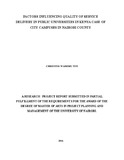| dc.description.abstract | Public Universities comprise of institutions that are part of the government apparatus. For service delivery to be effective in any institution, the beneficiaries must be able to access services when required. The purpose of this study was to establish the factors influencing quality service delivery in public universities in Kenya: a case of City campuses in Nairobi County. The study sought to establish how leadership, institutional funding, competiveness, technological changes and human resource management, influences the quality of service delivery in public universities in Nairobi City County. The target population was 7,740 individuals which was derived from Students and the University staff (Academic and non-academic) of 5 public university satellite campuses in Nairobi City County.The questionnaire rate of return was 95% for students and 97% for staff. The data collected was analyzed, interpreted and presented using tables and frequencies. It was found that the four objectives of the study influenced the quality service delivery of the public university satellite campuses. It was established that bureaucracy is a key area that needs to be addressed. 39(52.7%) of the staff members agreed that there was bureaucracy in their institutions . From the results majority agreed that decision making process was efficient as well as participatory management .The results showed that across the campuses 31(41.9%) were in agreement while 18(24.3%) strongly agreed that there was participatory management in the institutions. Another aspect of leadership was having well laid down communication structures. Majority of the staff members agreed that communication policies were well laid down ,having 7(41.2%) of JKUAT,6(40%) from Kimathi,12(46.2.%) from Moi ,3 (42.9%) from Masaai Mara and 3(42.9%) from Jaramogi .O .O. Further we had (35.3%) in JKUAT,3(20%) in Kimathi, 9(34.6%) of Moi ,3 (33.3%) and 2(28.6%) in Jaramogi .O .O. who strongly agreed that there were well laid down communication policies in their organizations. The study found that the curriculums by the university were up to date with 139(40.4%) being in agreement and 121(35.4%) strongly agreeing that there were suitable teaching methods. The results also slightly differed on the opinion of whether the use of up to date teaching methodologies was in place. This meant that there should be an improvement of the teaching methodologies to match the curriculum to ensure that the institutions remained competitive. However the students were not satisfied with the range of programs offered by their respective institutions with 106(30.8%) strongly disagreeing and 144(41.9%) in disagreement. The study further revealed the need for this institutions to increase essential academic facilities to enable students get quality education, having a total of 155(45.1%) and 40(11.6%) who agreed and strongly agreed respectively that their campuses had adequate academic facilities . The five institutions had embraced modern technology, having 35(47.3%) and 16(21.6%) being in agreement and strongly agreement respectively. The rate at which the staff had embraced technology was abit lower compared to the rate at which the institutions adopted it , 27(36.5%) being in agreement and 11(14.9%) strongly agreeing . The researcher established that for satellite campuses to offer high quality services there was need to reduce bureaucracy to ease and hasten services offered .The leadership of this institutions should work towards a thinner organization and enhance open door policy .More training that are core to staff should be conducted both in HRM and IT . The following were suggested for future research. Given that Nairobi is the capital city and given different experiences that satellite campuses face in other Semi urban areas, similar research should be done in other counties in order to generalize conclusion .Similar research should also be done in main campuses, ,private universities and tertiary colleges. This would bring fair competition hence benefiting both the students and the staff as well as sustain and enhance quality service delivery in education institutions. | en_US |



